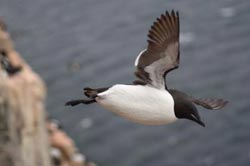Diving seabirds: Working hard and living long

Brünnich's guillemots have the highest flight costs of any bird. Credit: Kyle Elliott<br>
The guillemots – which look similar to penguins but can fly – have the highest flight costs of any bird and expend substantial energy for diving. Their high metabolisms and frequent dives should produce oxidative stress, causing the birds to deteriorate as they age. But, the researchers discovered that the birds stay fit and active as they grow older, maintaining their flying, diving, and foraging abilities.
Kyle Elliott, a PhD student at the University of Manitoba and the study's lead author, said, “Most of what we know about aging is from studies of short-lived round worms, fruit flies, mice, and chickens, but long-lived animals age differently. We need data from long-lived animals, and one good example is long-lived seabirds.”
Elliott also said, “Not only do these birds live very long, but they maintain their energetic lifestyle in a very extreme environment into old age.”
One bird, nicknamed 'Wayne Gretzky' by the researchers (after the Canadian hockey great who played 20 seasons and because the bird's identification band colours matched Gretzky's team colours), raised young for 18 consecutive years.
Over 4 consecutive summers, researchers periodically tracked Brünnich's guillemots' fitness, recording how deep and for how long they would dive for prey, how far and fast they would fly, and how much energy they expended on these activities. They looked for changes in the birds' behaviour and metabolism.
Media Contact
More Information:
http://www.sebiology.org/All latest news from the category: Life Sciences and Chemistry
Articles and reports from the Life Sciences and chemistry area deal with applied and basic research into modern biology, chemistry and human medicine.
Valuable information can be found on a range of life sciences fields including bacteriology, biochemistry, bionics, bioinformatics, biophysics, biotechnology, genetics, geobotany, human biology, marine biology, microbiology, molecular biology, cellular biology, zoology, bioinorganic chemistry, microchemistry and environmental chemistry.
Newest articles

Trotting robots reveal emergence of animal gait transitions
A four-legged robot trained with machine learning by EPFL researchers has learned to avoid falls by spontaneously switching between walking, trotting, and pronking – a milestone for roboticists as well…

Innovation promises to prevent power pole-top fires
Engineers in Australia have found a new way to make power-pole insulators resistant to fire and electrical sparking, promising to prevent dangerous pole-top fires and reduce blackouts. Pole-top fires pose…

Possible alternative to antibiotics produced by bacteria
Antibacterial substance from staphylococci discovered with new mechanism of action against natural competitors. Many bacteria produce substances to gain an advantage over competitors in their highly competitive natural environment. Researchers…





















